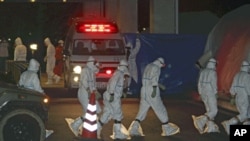Two workers at the Fukushima 1 nuclear power plant have been hospitalized for radiation exposure suffered on Thursday.
They are among those frantically trying to get critical cooling functions restored to damaged reactors and fuel ponds.
Radiation also continues to be detected above normal levels as far as 300 kilometers south of the facility, which was knocked out of commission by a huge quake and tsunami nearly two weeks ago.
Excessive radiation exposure
The hospitalized workers were exposed to excessive radiation exposure following an accident Thursday.
Japan's chief cabinet secretary Yukio Edano told reporters that two of three men working together in the damaged Number 3 reactor's turbine building slipped into water and did not realize they had been exposed to high levels of radiation until they noticed a rash on their skin.
The two are said to be suffering from beta ray burns.
Tokyo Electric Power Company Vice President Sakae Muto says the men were underground laying cable critical to restarting the cooling system for the reactor, which contains a mix of plutonium and uranium fuel.
All three workers were exposed to between 170 and 180 milliseverts of radiation, said Muto. That is less than the maximum of 250 millisieverts for workers at the plant that has been set by the government. About 25 people injured at the nuclear plant since it began leaking radiation following damage on March 11 from the quake-triggered tsunami.
Crucial repair work continues
Emergency repair work resumed at the plant on Thursday, after a break the previous day when black smoke was again seen at the Number 3 reactor.
Video taken from a helicopter Thursday morning shows what appears to be steam rising from four of the nuclear facility's six reactor buildings. Authorities said the situation was not serious enough to continue a halt in the critical work to prevent a potentially larger catastrophe.
If water is not replenished to pools, exposed used fuel could release significant amounts of radioactive substances.
New worries emerge
There is also fresh concern about the damaged Number 1 reactor, where pressure inside the reactor again increased. Crews are trying to maintain a delicate balance between spraying water on the radioactive fuel, which causes a rise in pressure, and reducing the water flow which could see temperatures increase to a dangerously high level.
Since the March 11 magnitude 9.0 earthquake, which triggered a destructive tsunami, the nuclear power complex has experienced many serious problems. These include hydrogen explosions in reactor buildings, radiation leaks, exposed and overheating fuel rods, damage reactor cores and shaking from powerful aftershocks.
Radiation continues to be detected in the surrounding air, soil and sea water.
James Symons, the director of the nuclear science division at the Lawrence Berkeley National Laboratory in California, says at this stage, the Fukushima disaster has more in common with the 1979 Three Mile Island partial meltdown in the United States than the 1986 Chernobyl catastrophe in Ukraine.
"All these things are different. But it's closer. It's certainly very unlike what happened at Chernobyl, where the entire reactor exploded, basically," he said. "It's certainly very serious, but - as far as we can tell - it's also coming under control."
Japan's government says the detection of radioactive neutron beams 15 times near the plant following the destruction by the tsunami were natural events and there is no evidence any uranium and plutonium leaked from reactors.
A government spokesman in Tokyo, as well as Symons at the laboratory in Berkeley, both reject assertions by some overseas in the industry that a critical nuclear reaction from a reactor or spent fuel rods likely emitted the neutron beams.
Zone warnings expanded
Japan's government is now advising people beyond the 30-kilometer exclusion zone around the Fukushima plant to remain indoors. Officials say that, since the explosions, some infants theoretically may have accumulated 100 millisieverts of radiation in their thyroids.
Some scientists say those exposed to that total radiation dose should take potassium iodide, because an annual dose above 100 millisieverts is believed to be associated with an increased risk of cancer.
Japan's science ministry says radiation levels detected in Tokyo have tripled, compared to those detected earlier in the week.
The Tokyo metropolitan government, and the governments in the adjacent prefectures of Chiba and Saitama, has announced levels of radioactive iodine considered unsafe for infants were detected this week in tap water, sparking panic- buying of bottled water.
Vegetable shipments have been stopped out of areas adjacent to the nuclear power plant after some leafy greens were found to be contaminated with levels of radioactive iodine and cesium exceeding government standards.














